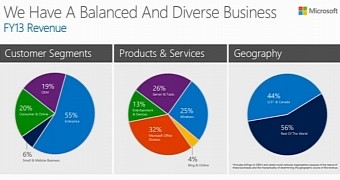Back on January 21, Microsoft's Joe Belfiore announced that Windows 10 would be completely free of charge for those running Windows 7 or Windows 8.1 on their computers, but only if the upgrade is made during the first year after launch.
What this means is that Windows 10 won't cost a thing if you download and install it within the first 12 months of availability, but provided that your computer currently runs Windows 7 or Windows 8.1. If you want to get it after the first year, you might have to pay a price that's yet to be disclosed.
Basically, it all seems like milk and honey for customers who will finally get a free Windows operating system that comes on pretty much all their devices, including PCs and tablets.
But in reality, making Windows 10 free of charge was a necessity and not a way to win back customers who were disappointed with Windows 8. Microsoft had no other choice than to offer the upcoming operating system for zero dollars because of a simple yet critical thing: it needs people to upgrade.
And we'll detail this reason in the following paragraphs.
Only free for consumers
The free Windows 10 promo could be easily considered a godsend, given the fact that customers can finally upgrade their computers to the latest Windows version without paying a single cent, but when looking closely at what this campaign means, it becomes very clear that Microsoft is embracing a very smart and effective strategy.
The key market for the Windows division is the enterprise market, and a graph that Microsoft revealed some time ago when reporting its FY2013 revenues is living proof.
Windows accounts for only 25 percent of Microsoft's business, which makes it only the third most important product in its portfolio. Office continues to be the number one cash cow with 32 percent, while Server & Tools comes second with 26 percent.
As far as customers are concerned, enterprises get no less than 55 percent of this business, while consumers account for only 20 percent. Microsoft has said on several occasions that enterprises are the ones bringing in the cash, so consumers aren't exactly the number one source of profit for the Redmond-based software giant.
Selling Windows licenses to consumers is clearly less important than selling them to enterprises, and it's easy to see why. Organizations and companies usually purchase many more licenses, in most of the cases for the top products and versions, and are willing to spend more for support and additional services.
And here's the secret behind the free Windows 10 offer. Consumers will be indeed allowed to upgrade to Windows 10 free of charge, but this isn't the industry that brings Microsoft the bacon. It's the enterprise. And guess what? Enterprises will still have to pay for Windows 10.
Free Windows 10 equals more new PCs sold
So consumers get it free of charge, enterprises need to pay. And yet, there's one more Windows industry that helps Microsoft make some money: OEMs.
According to the very same graph, OEMs represent 19 percent of Microsoft's business, and yes, Windows 10 will be available with a fee for them too. And OEMs are at least as important as enterprises are.
OEMs will have to pay licensing fees to install Windows 10 on their devices (unless Microsoft decides otherwise before the new OS hits the market), so the Redmond-based tech giant is once again generating additional revenues.
On the other hand, making Windows 10 available with a fee for OEMs is a double-edged sword. Paying for a license could also increase the final price of a Windows 10 device, so Microsoft could counter this by making the operating system free of charge in the same way it did for small tablets and smartphones.
If it indeed makes Windows 10 free of charge, the company could help sell more PCs and devices powered by its operating system, so once again, it would speed up the transition to this modern platform.
So let's see a wrap-up of all of the above:
• Windows 10 will be free for 20 percent of the Windows user base (55 percent are enterprises, 19 percent are OEMs) • out of the 20 percent, some are still running Windows XP, Vista, or an even older OS • out of the Windows 8.1 and Windows 7 users eligible to upgrade, some might not do it for various reasons • out of those running Windows 8.1 and Windows 7, an undisclosed percentage are not running genuine copies of the OS or do not have an Internet connection to benefit from the upgrade
Smart. Very smart. Making Windows 10 free of charge, but still making money with it.
Obviously, Windows 10 is easily becoming a game changer for Microsoft, so there's no doubt that the software vendor needs to play its cards right this time to finally bring more people on an operating system that's designed from the ground up with help from its users.

 14 DAY TRIAL //
14 DAY TRIAL //